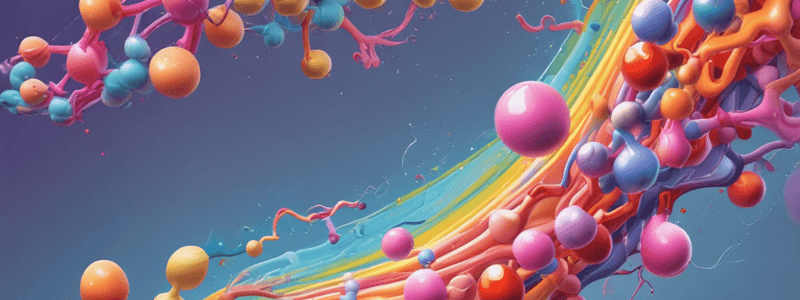Podcast
Questions and Answers
What is the first enzyme involved in converting pyruvate to phosphoenolpyruvate in the bypass reaction?
What is the first enzyme involved in converting pyruvate to phosphoenolpyruvate in the bypass reaction?
- Malate dehydrogenase
- Pyruvate carboxylase (correct)
- Pyruvate kinase
- Lactate dehydrogenase
Where does the conversion of pyruvate to oxaloacetate occur in the first step of the bypass reaction?
Where does the conversion of pyruvate to oxaloacetate occur in the first step of the bypass reaction?
- Golgi apparatus
- Endoplasmic reticulum
- Cytosol
- Mitochondria (correct)
Under what conditions does pyruvate serve as the precursor in the bypass reaction instead of lactate?
Under what conditions does pyruvate serve as the precursor in the bypass reaction instead of lactate?
- [Lysine] is high and NADH is needed in the cytosol
- [Glucose] is high and NADH is needed in the cytosol
- [Pyruvate] is high and NADH is needed in the cytosol (correct)
- [Lactate] is high and NADH is needed in the cytosol
Why does oxaloacetate need to be transported outside mitochondria in the first step of the bypass reaction?
Why does oxaloacetate need to be transported outside mitochondria in the first step of the bypass reaction?
Which enzyme catalyzes the conversion of oxaloacetate to PEP in the second step of the bypass reaction?
Which enzyme catalyzes the conversion of oxaloacetate to PEP in the second step of the bypass reaction?
Which of the following amino acids can be converted to pyruvate or oxaloacetate during gluconeogenesis?
Which of the following amino acids can be converted to pyruvate or oxaloacetate during gluconeogenesis?
Which of the following statements about glycerol is true?
Which of the following statements about glycerol is true?
Which of the following organisms can convert fatty acids to carbohydrates?
Which of the following organisms can convert fatty acids to carbohydrates?
What is the product of fatty acid degradation in mammals?
What is the product of fatty acid degradation in mammals?
Which of the following metabolic pathways is involved in the conversion of carbon dioxide to carbohydrates?
Which of the following metabolic pathways is involved in the conversion of carbon dioxide to carbohydrates?
What is the enzyme responsible for converting fructose 1,6-bisphosphate to fructose 6-phosphate in gluconeogenesis?
What is the enzyme responsible for converting fructose 1,6-bisphosphate to fructose 6-phosphate in gluconeogenesis?
Which molecule is the starting substrate for the enzyme glucose 6-phosphatase in gluconeogenesis?
Which molecule is the starting substrate for the enzyme glucose 6-phosphatase in gluconeogenesis?
Which molecule is produced from the conversion of fructose 1,6-bisphosphate to fructose 6-phosphate in gluconeogenesis?
Which molecule is produced from the conversion of fructose 1,6-bisphosphate to fructose 6-phosphate in gluconeogenesis?
Which molecule is generated from the reaction catalyzed by glucose 6-phosphatase in the process of gluconeogenesis?
Which molecule is generated from the reaction catalyzed by glucose 6-phosphatase in the process of gluconeogenesis?
Which of the following statements is true about the relationship between glycolysis and gluconeogenesis?
Which of the following statements is true about the relationship between glycolysis and gluconeogenesis?
Which of the following statements is correct regarding the regulation of glycolysis and gluconeogenesis?
Which of the following statements is correct regarding the regulation of glycolysis and gluconeogenesis?
Which of the following statements is true about the irreversible reactions in glycolysis?
Which of the following statements is true about the irreversible reactions in glycolysis?
In which cellular compartments do glycolysis and gluconeogenesis primarily occur?
In which cellular compartments do glycolysis and gluconeogenesis primarily occur?
Which of the following accurately describes the role of biotin in the pyruvate carboxylase reaction?
Which of the following accurately describes the role of biotin in the pyruvate carboxylase reaction?
In which cellular compartment does the pyruvate carboxylase reaction occur?
In which cellular compartment does the pyruvate carboxylase reaction occur?
Which of the following enzymes also utilizes the biotin-dependent carboxylation mechanism?
Which of the following enzymes also utilizes the biotin-dependent carboxylation mechanism?
What is the ultimate fate of the CO2 incorporated into oxaloacetate by the pyruvate carboxylase reaction?
What is the ultimate fate of the CO2 incorporated into oxaloacetate by the pyruvate carboxylase reaction?
Which of the following statements accurately describes the conversion of oxaloacetate to phosphoenolpyruvate?
Which of the following statements accurately describes the conversion of oxaloacetate to phosphoenolpyruvate?
In the bypass reaction of gluconeogenesis, which enzyme catalyzes the conversion of pyruvate to oxaloacetate?
In the bypass reaction of gluconeogenesis, which enzyme catalyzes the conversion of pyruvate to oxaloacetate?
Which enzyme catalyzes the conversion of fructose 1,6-bisphosphate to fructose 6-phosphate in the gluconeogenic pathway?
Which enzyme catalyzes the conversion of fructose 1,6-bisphosphate to fructose 6-phosphate in the gluconeogenic pathway?
In the second step of the bypass reaction, which enzyme catalyzes the conversion of oxaloacetate to phosphoenolpyruvate (PEP)?
In the second step of the bypass reaction, which enzyme catalyzes the conversion of oxaloacetate to phosphoenolpyruvate (PEP)?
Which of the following statements accurately describes the role of biotin in the pyruvate carboxylase reaction?
Which of the following statements accurately describes the role of biotin in the pyruvate carboxylase reaction?
Flashcards are hidden until you start studying




